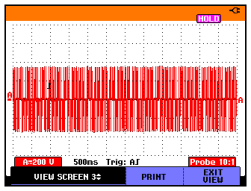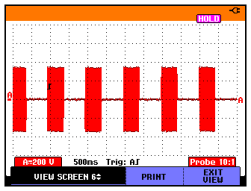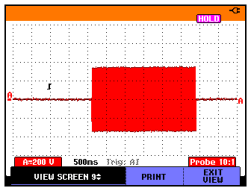Understanding SCR Power Controls
When selecting SCR Power Controls, it is important to have a basic understanding of how SCRs work. This will help you select the right SCR for your application.
How SCR Power Controls Work
A silicon controlled rectifier (SCR) is a solid state switching device which can provide fast, infinitely variable proportional control of electric power. Not only does this give maximum control of your heat process, but it can extend heater life many times over other control methods. Since the SCR is solid state, it can cycle on and off over a billion times, if properly used.
The advantages of SCR Controls over other temperature control methods
- Improved response time.
- Closer process control.
- Extended heater life.
- Reduced maintenance costs.
- Silent operation. No arcing and sparking.
- Reduced peak power consumption.
Remember, a heating element is made of wire in most cases. If you use a mechanical relay to turn on your heater, it will cycle on or off within 30 seconds or longer. The heater will expand and contract, getting more and more brittle each time. This is called thermal shock. Temperature overshoot may also occur. Relays also arc, spark and will burn out on a regular basis.
Mercury displacement relays can cycle from 3-15 seconds. While it controls better than a mechanical contractor, overshoot and thermal shock will still occur. If cycled too fast, Mercury relays can overheat and explode causing Haz-Mat problems.
Selection Guide
The chart below shows how to best match SCR power control with typical applications.
| Heater/Load Type |
Heater/Load Characteristics |
Control Type | Typical Applications |
Model Number |
|---|---|---|---|---|
| Constant Resistance Elements. Immersion heaters. |
Slow Response | On/Off Zero Voltage Switched |
Large tank heating and mechanical relay replacement. |
A1Z A3Z A6Z R1 CZ |
| Medium wave infrared, ceramic, cartridge, duct, strip, and band heaters. Platens. | Faster response, Constant resistance heaters only. | Zero Voltage Switched | Thermoforming, textiles, industrial furnaces and ovens, extruders, kilns, chemical process heating, fast water heat. |
A1Z A3Z CZ D1P 2CP-8CP |
| Open coil/wire heaters. Medium wave IR quartz. IR panels. | Fastest, most precise response. | Phase Angle Fired | Paper and pulp drying, packaging machines, pharmaceutical processes, infrared ovens & dryers. |
A1P C1P A3P D1P 2CP-8CP |
| Silicon Carbide heaters. |
Load changes in resistance with age. High temperature elements. | Phase Angle Fired with Current Limit Option | High temperature ovens and furnaces, glass, ceramics and high temperature alloys. |
A1P-CL A3P-CL |
| Tungsten (T-3) lamps and heaters. Short wave IR elements. Molybdenum heaters. | High inrush currents High hot: cold resistance ration Tungsten 14:1 Molybdenum 20:1 Graphite: 20:1 |
Phase Angle Fired with Soft Start option | High speed paper and ink dryers, high temperature IR heating, high temperature materials processing. |
A1P-Sxx A3P-Sxx C1P-S 2CP-S-8CP-S |
| Transformer coupled loads. Primary driving. Inductive heater loads. | Inductive loads. | Phase Angle Fired with Soft Start option. Current limit option. | Used with transformer-coupled heater loads to drive low voltage elements. |
B1P B2P B3P |
Product Notes
- All A series controls have fusing of controlled legs as standard.
- All A. B. C Series controls have isolated 4-20mA command signal as standard. Other available.
- All Avatar Power Controls have isolated & grounded chassis and SCR blocks as standard.
- 4 wire 3 Phase systems should use either A6Z, 3CP or 3 single phase controls.
SCR Power Control In Depth
The SCR control can deliver electrical power to heaters in several ways: phase angle fired, zero voltage switched and on/off control.
Phase Angle Fired
These controls proportionally turn on a percentage of each power line half cycle. This gives smooth, infinitely variable application of power to the heaters. Imagine a light dimmer and how it provides power to a light bulb. This method will provide the most precise control of heaters. Phase angle fired SCR’s will respond the fastest to load change and provide maximum heater life. It is the most precise method of control. Phase angle firing can increase heater life up to seven times depending on heater type. Phase angle firing also allows options such as soft start, voltage limit and current limit. These options are not available with any other means of control.
Equipment manufacturers and maintenance engineers need a reliable, flexible approach to controlling electric-heating processes in today’s competitive, cost-conscious, industrial environment. And making the right choices up front is vitally important.
Let us help you understand SCR Power Controls, compare power control methods in order to make the right selection, and determine the type of electrical enclosure you need.
Graphs below shows phase angle fired voltage output on a 240V power line.

|

|

|
| Graph shows 25% output or 60V RMS. | Graph shows 50% output, 120V RMS. | Graph shows 99.5% output or 238.8V RMS |
Zero Voltage Switched
Zero voltage switched controls proportionally turn on and off each full cycle of the power line cycle. By varying the number of AC power line cycles, the SCR provides power to the heaters. With a variable time base, the optimum number of cycles turned on/off is achieved. The switching is done at fractions of a second during the zero voltage crossing of the power line cycles. For IR heating with a fast element, you would see the elements flickering. On a ceramic heater, or more massive medium wave heater you can control within very tight tolerances.
Zero voltage switching controls proportionally turn on and off each full cycle of the power line. By varying the number of AC power line cycles, the SCR provides power to the heaters. With a variable time base, the optimum number of cycles turned on/off is achieved. This method produces less RFI line noise than phase angle fired SCRs. Power factor is 100%, while harmonic distortion is limited. Chart below shows 25% power output using variable time based zero voltage switching.
 |
 |
 |
| Avatar Instruments variable time base SCR firing. Note how half cycles can be turned on and off providing 0.08 second resolution. Above chart shows 50% output. | 100% output at 240V RMS. | |
| On/Off controls function the same way as a mechanical or mercury relay, with the advantage of much faster cycle times. Chart below shows an Avatar Instruments model A1Z SCR output with variable base time proportioning. Compare the output cycles against an SSR with a 1 second time base and a 5 second time base. The superior firing resolution and speed of response of the A1Z SCR is instantly apparent. |  Avatar Instruments A1Z SCR 50% output with variable time base zero voltage switching. |
To show the full effect, the scope had to be set on a 500ms scale, or 5X longer time base than the 100ms screen above.

|

|

|
| Avatar A1Z zero voltage switched SCR | SSR with 1 second on-off time base. | On-Off 5 second on-off, which would cause failure if used with mercury displacement relays |